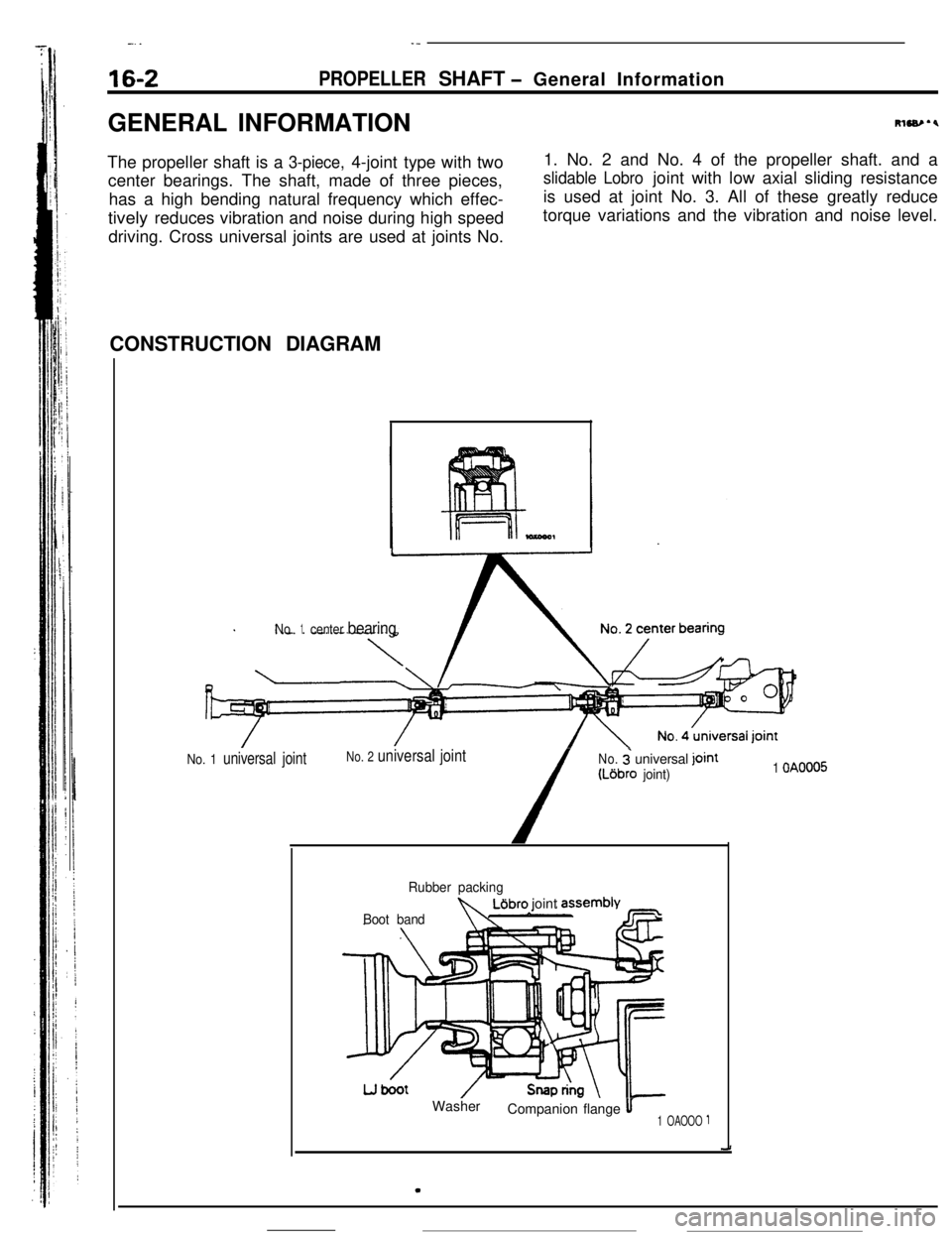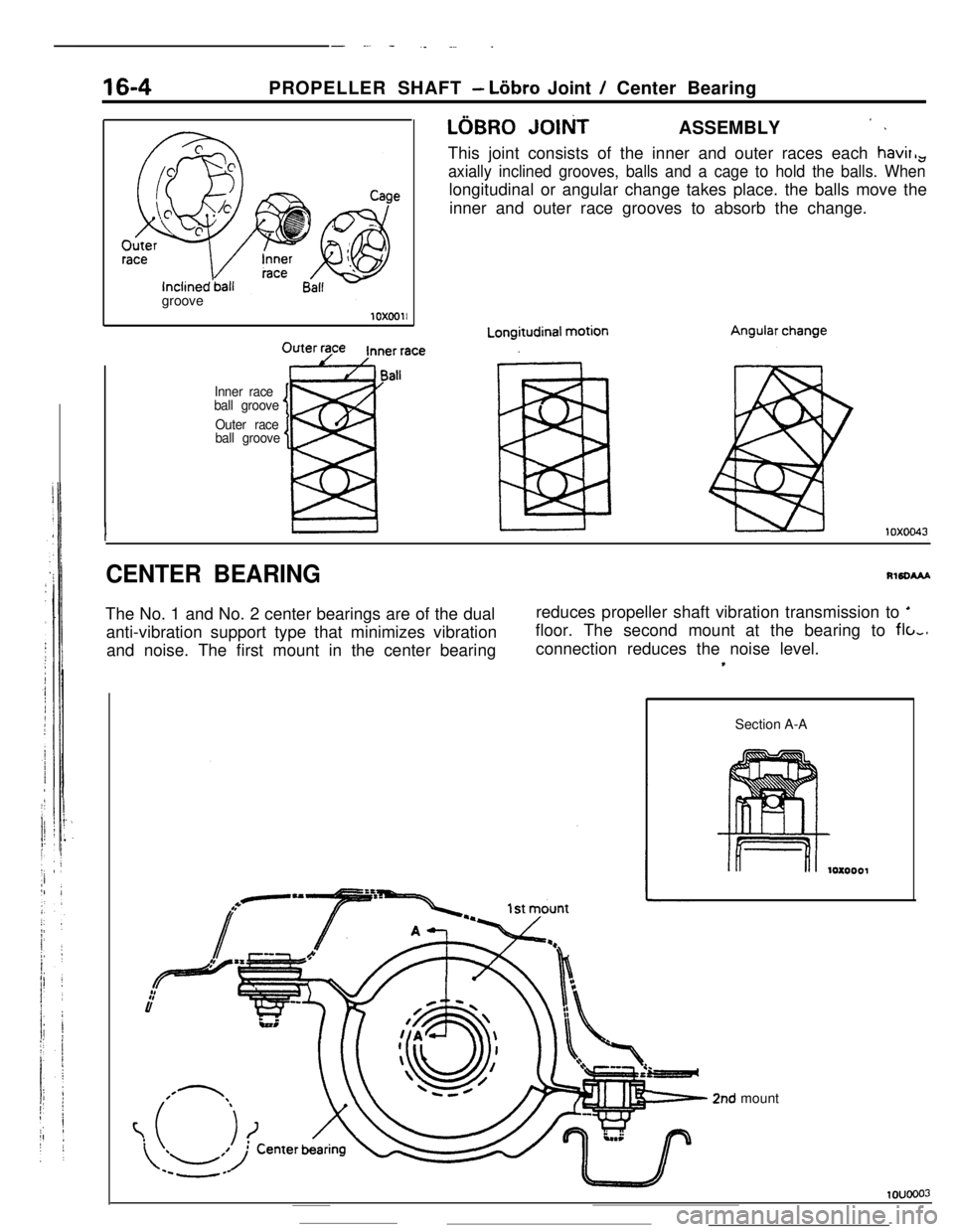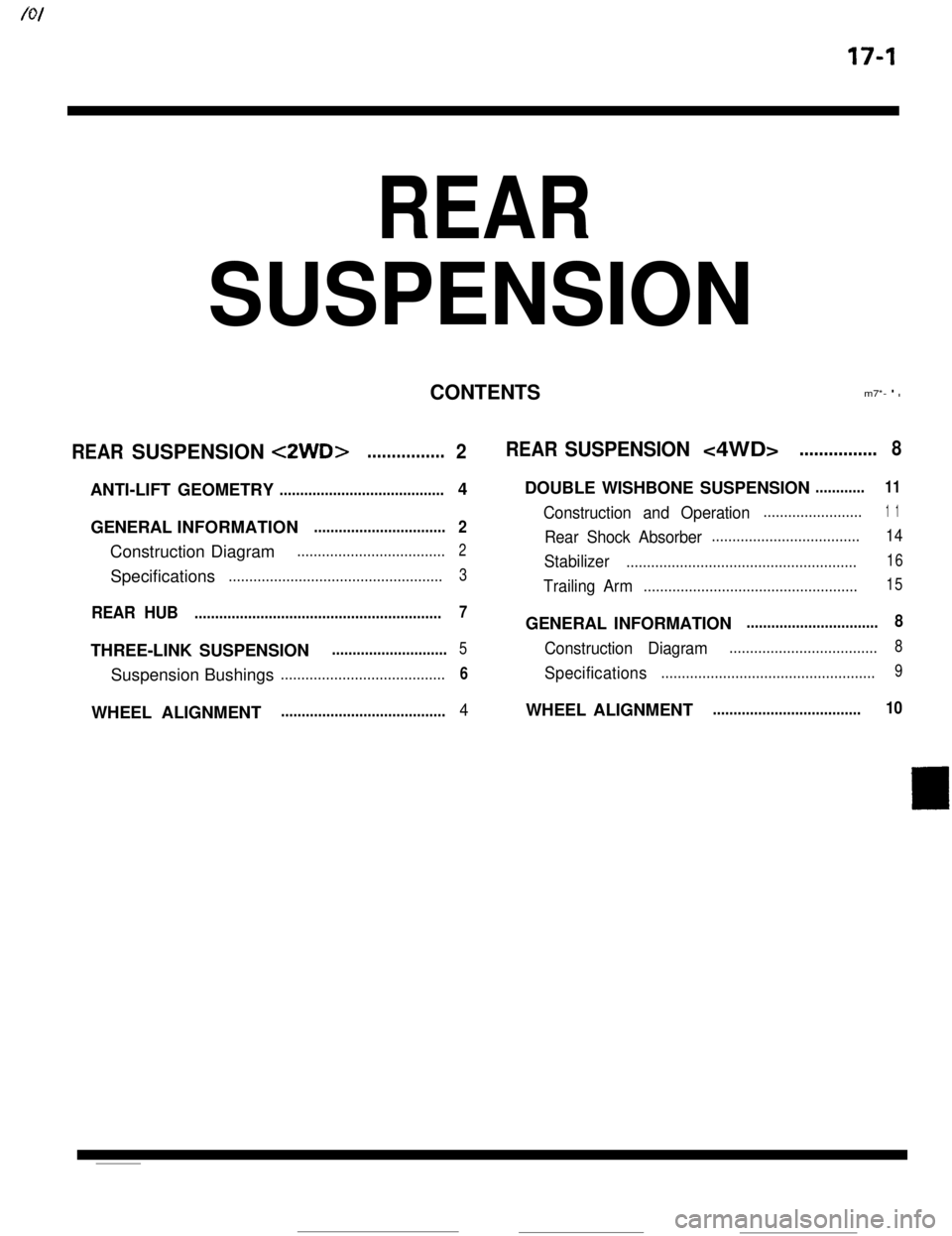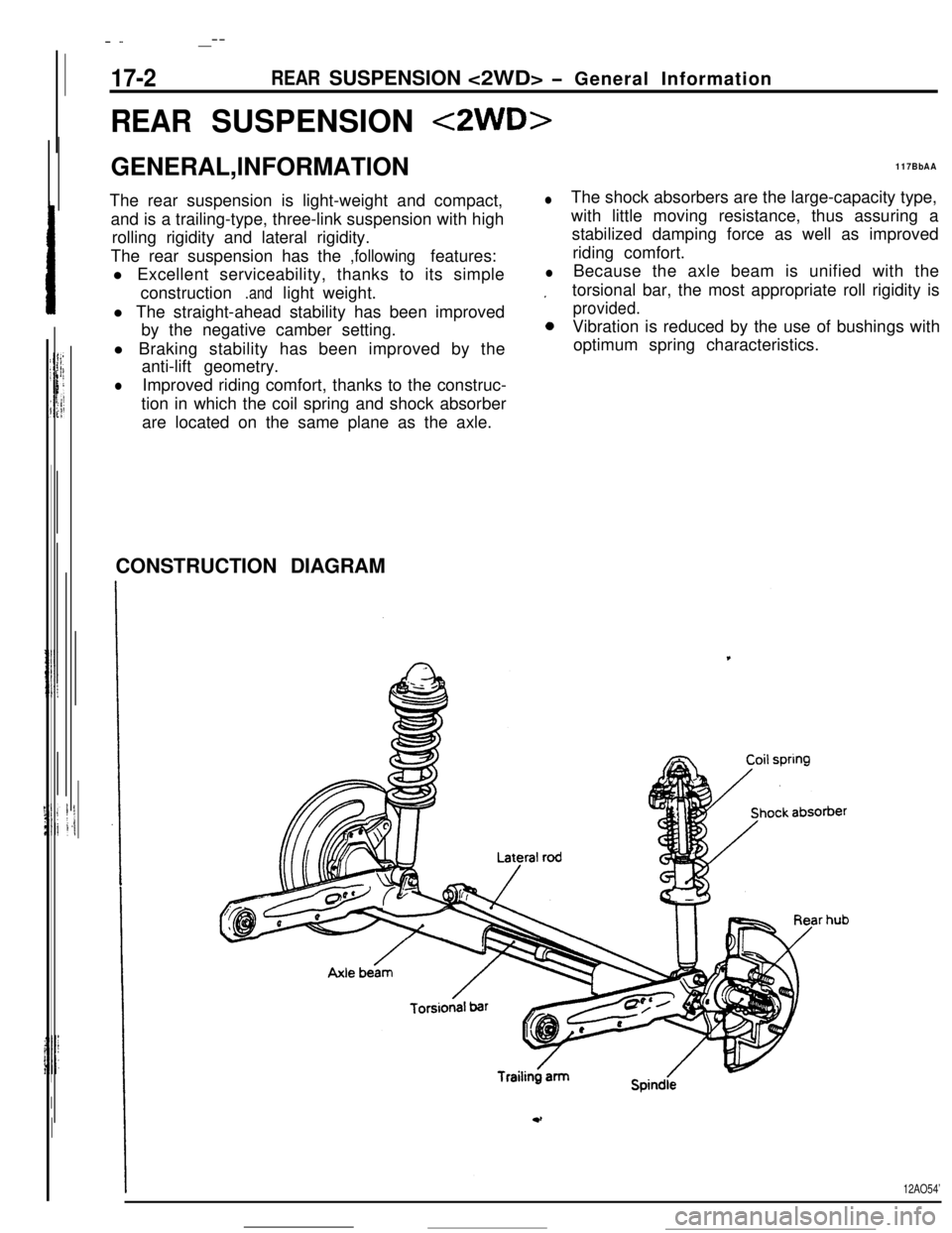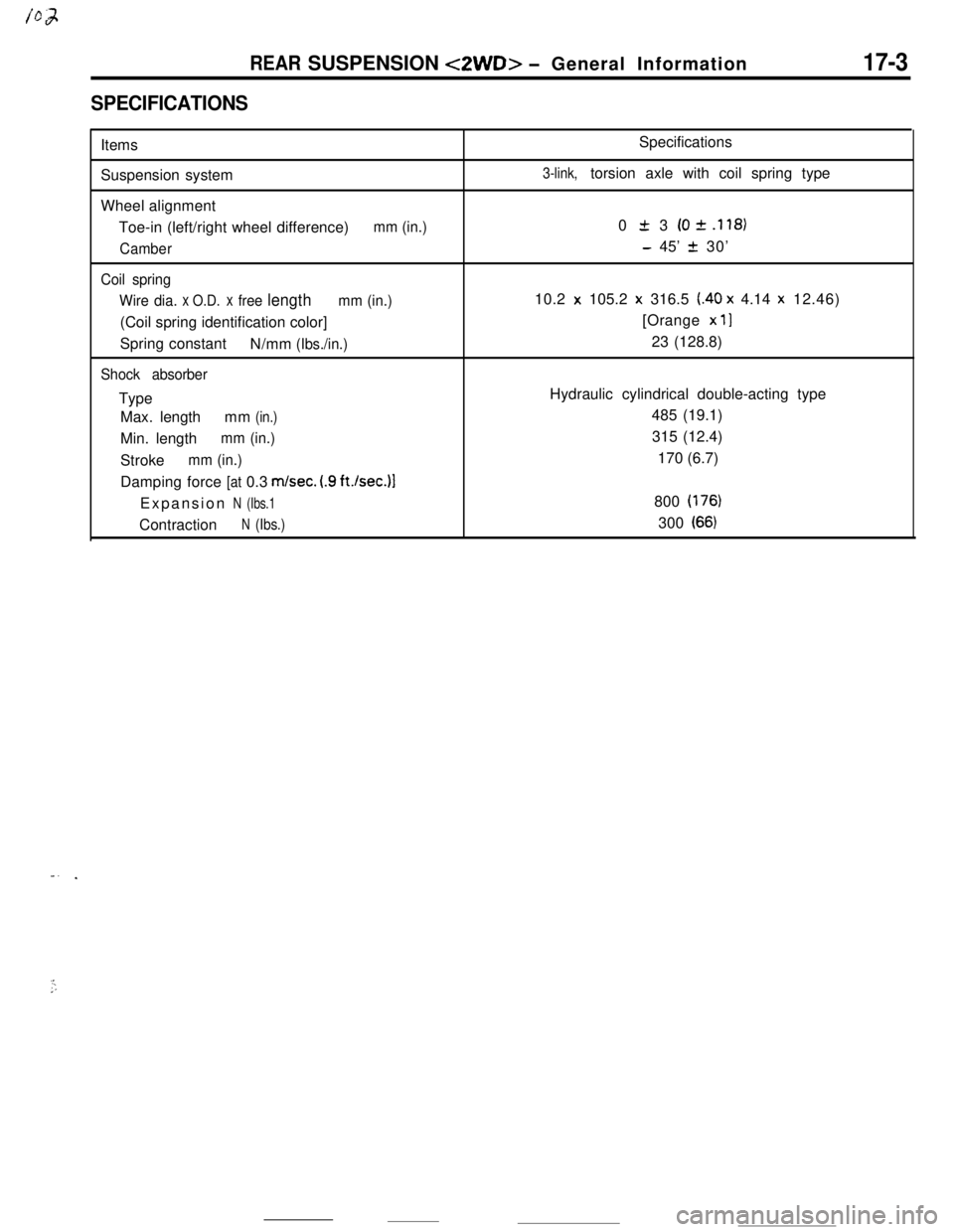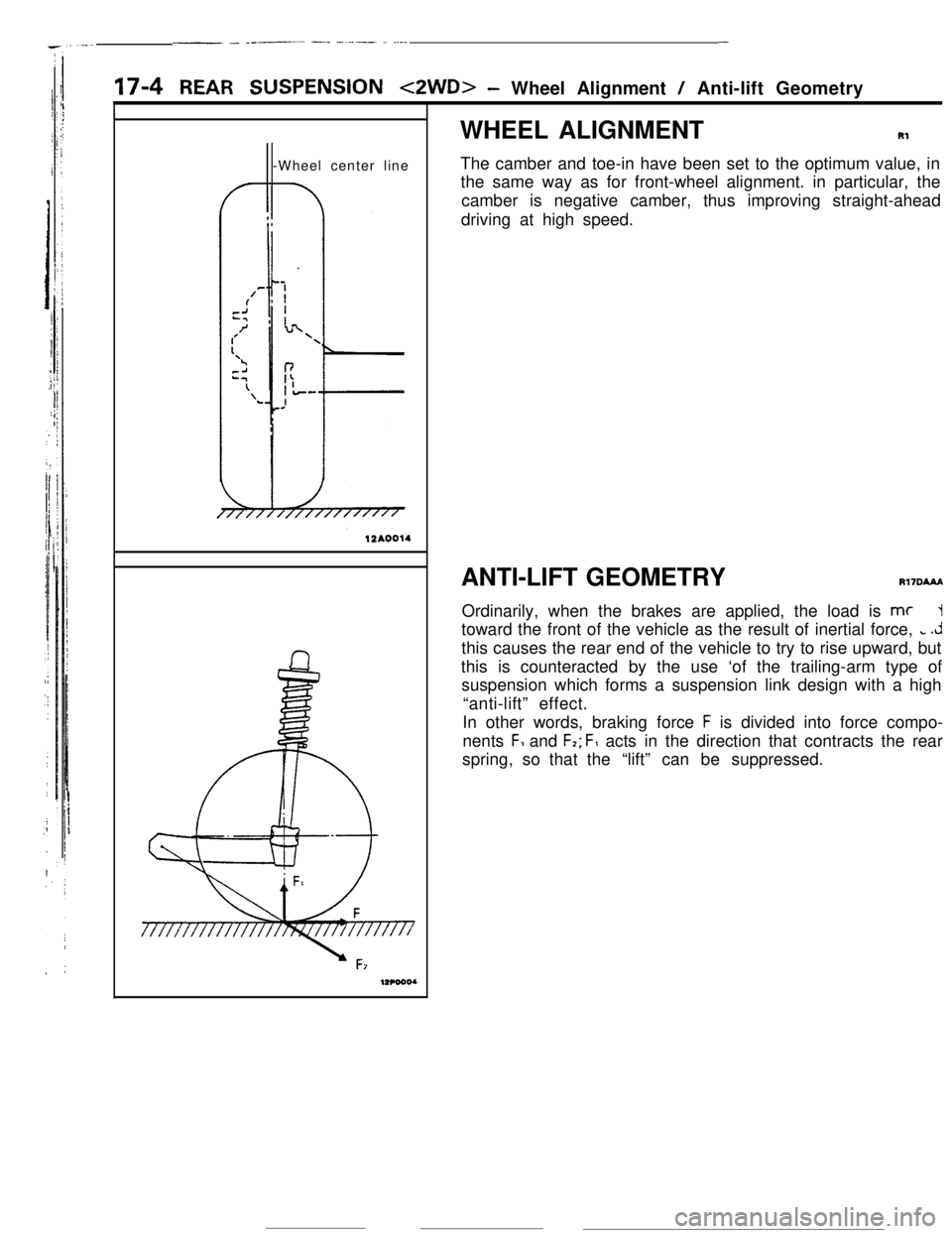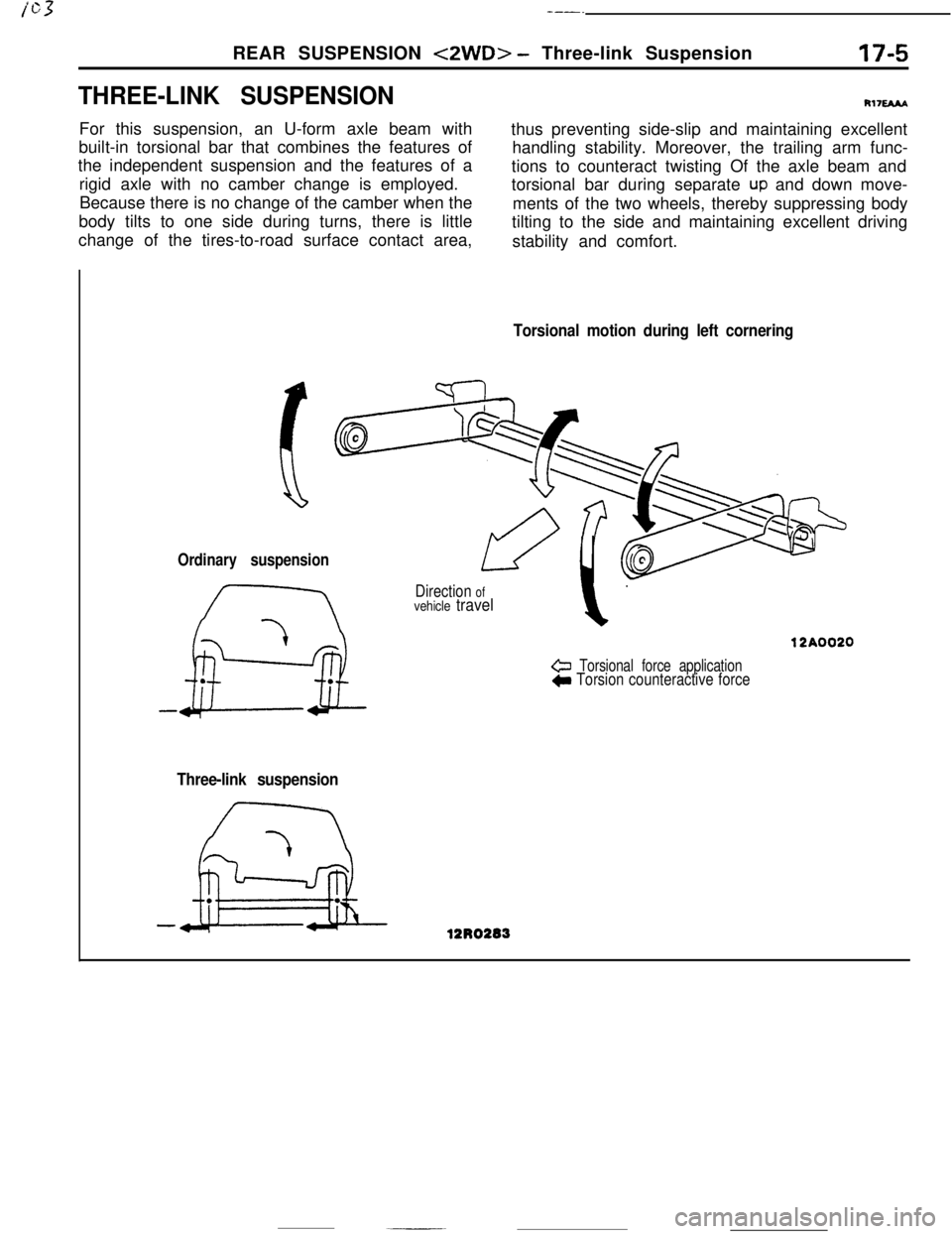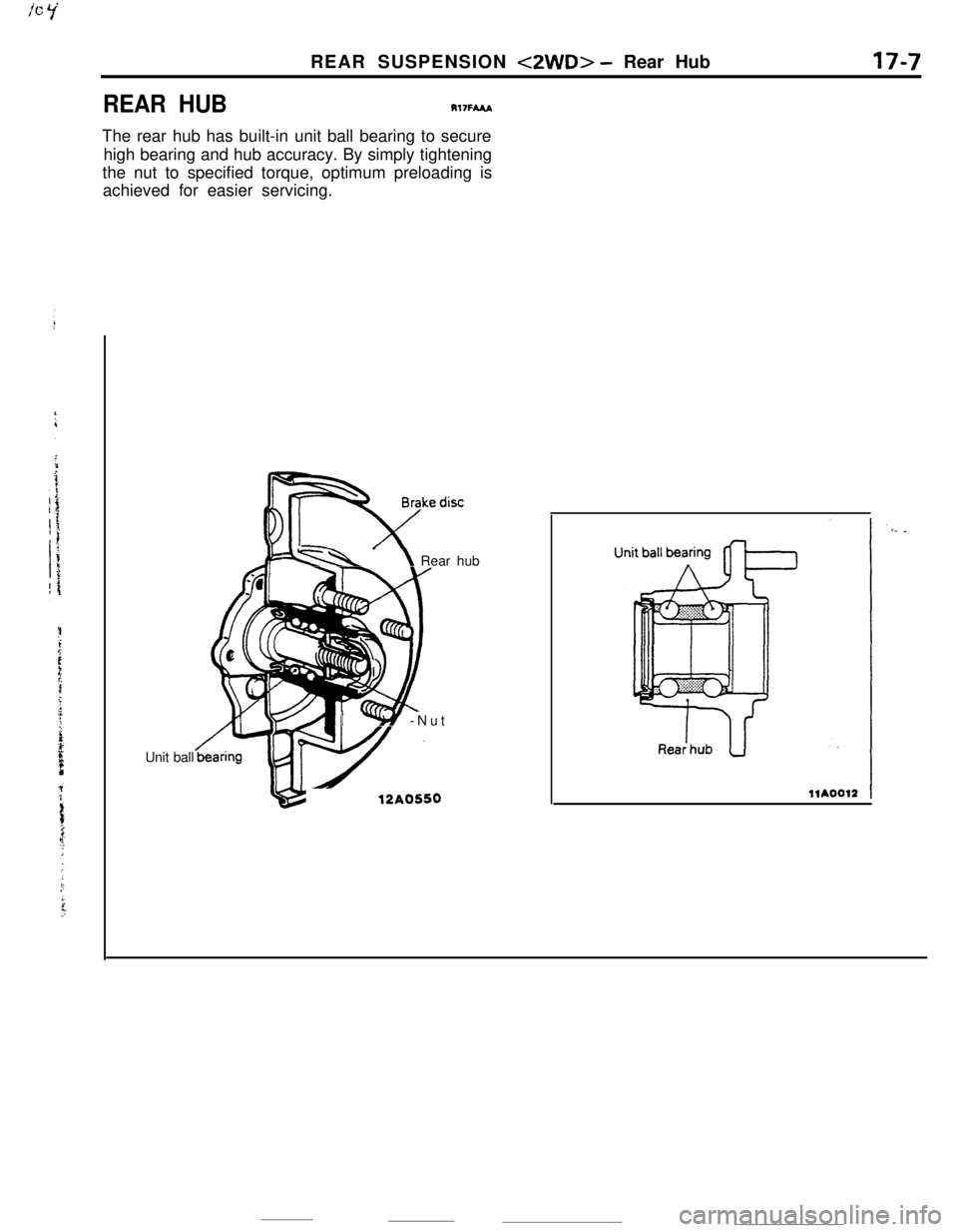MITSUBISHI ECLIPSE 1990 Service Manual
ECLIPSE 1990
MITSUBISHI
MITSUBISHI
https://www.carmanualsonline.info/img/19/57103/w960_57103-0.png
MITSUBISHI ECLIPSE 1990 Service Manual
Trending: catalytic converter, dimensions, brake light, key, wheel, timing belt, battery
Page 191 of 391
-. .-_
16-ZPROPELLER
/No.i universal joint
/
(LBbro joint)1 OA0005
Rubber packing
Ldbro joint
Boot band
LJbool/WasherU1 OAOOO 1
.
Page 192 of 391
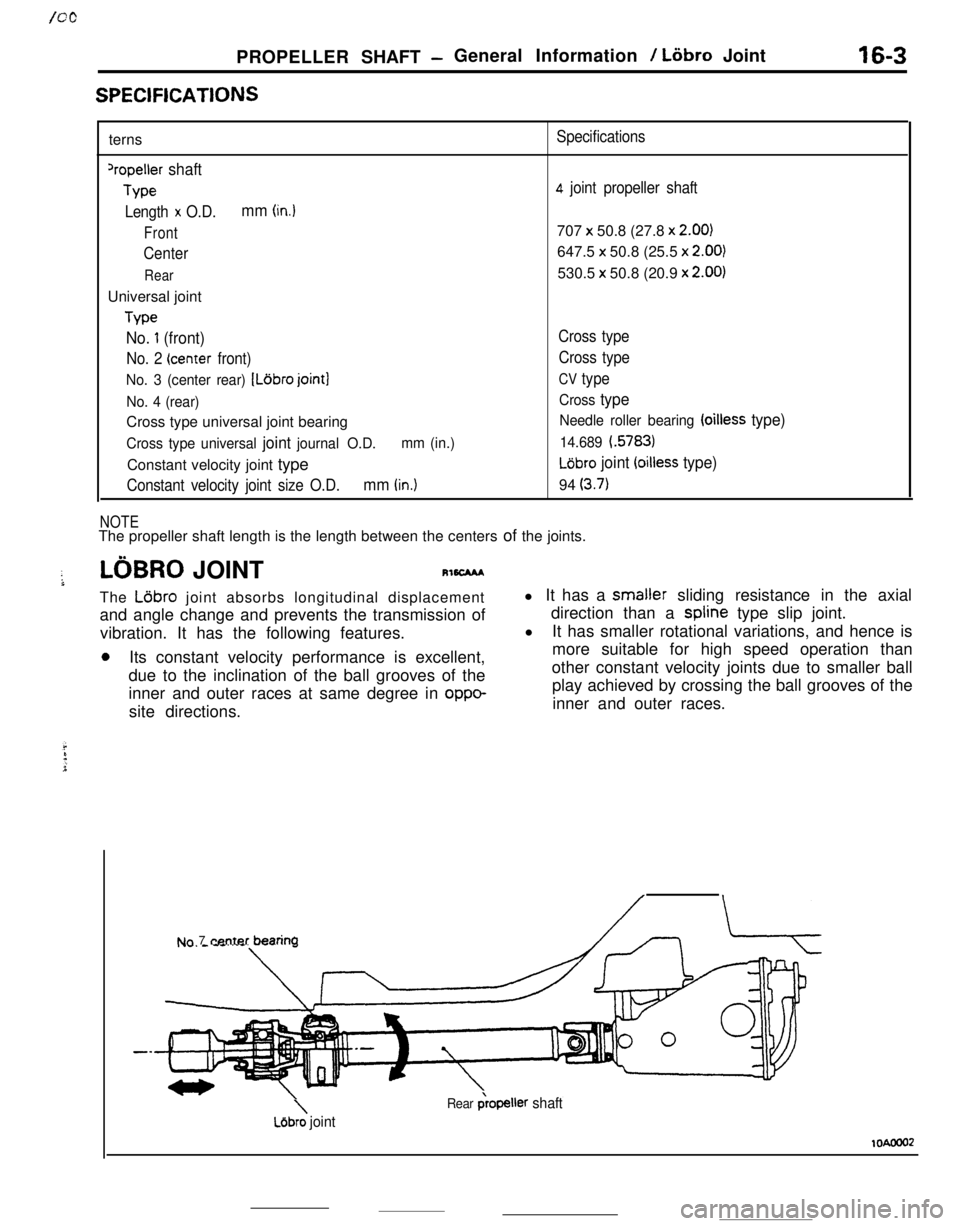
PROPELLER SHAFT -General Information / Liibro Joint16-3
SPEClFlCATlONSterns
‘repeller shaft
Type
Length
x O.D.mm (in.)
Front
Center
RearUniversal joint
Type
No. 1 (front)
No. 2 (center front)
No. 3 (center rear) [Ldbro joint]
No. 4 (rear)Cross type universal joint bearing
Cross type universal joint journal O.D.mm (in.)Constant velocity joint type
Constant velocity joint size O.D.mm (in.)
NOTE
Specifications
4 joint propeller shaft707
x 50.8 (27.8 x 2.00)647.5 x 50.8 (25.5 x
2.00)530.5 x 50.8 (20.9 x
2.00)
Cross type
Cross type
CV type
Cross type
Needle roller bearing (oilless type)
14.689 i.5783)
LGbro joint (oilless type)94
(3.7)The propeller shaft length is the length between the centers of the joints.
LOBRO JOINTRl6CMAThe
L6bro joint absorbs longitudinal displacement
and angle change and prevents the transmission of
vibration. It has the following features.
0Its constant velocity performance is excellent,
due to the inclination of the ball grooves of the
inner and outer races at same degree in
oppo-site directions.l It has a smaller sliding resistance in the axial
direction than a spline type slip joint.
l
It has smaller rotational variations, and hence is
more suitable for high speed operation than
other constant velocity joints due to smaller ball
play achieved by crossing the ball grooves of the
inner and outer races.
Nn 7 center bearina
\Lejbro joint
Rear &opeller shaft
lOAooo2
Page 193 of 391
- --- -._ -...PROPELLER SHAFT
- LBbro Joint / Center Bearing
groove
Inner race
ball groove
Outer race
ball grooveLGBRO
JOltiT ASSEMBLY ’ IThis joint consists of the inner and outer races each havir,,
axially inclined grooves, balls and a cage to hold the balls. Whenlongitudinal or angular change takes place. the balls move the
inner and outer race grooves to absorb the change.
CENTER BEARINGRlSDWThe No. 1 and No. 2 center bearings are of the dualreduces propeller shaft vibration transmission to ’
anti-vibration support type that minimizes vibrationfloor. The second mount at the bearing to
flo,,and noise. The first mount in the center bearingconnection reduces the noise level.
*Section A-A
2nd mount
1ouooo3
Page 194 of 391
17-I
REAR
................2
Page 195 of 391
_--
GENERAL,lNFORMATlON
’0
l Braking stability has been improved by the
Page 196 of 391
REAR tZWD> - General Information
m/set. (.9 ft.Isec.11
Expansion
2 3 IO zk .118)
- 45’ -c 30’
10.2 x 105.2 x 316.5 (.40 x 4.14 x 12.46)
[Orange x 11
23 (128.8)
(176)
300 (661
‘.‘.;-
Page 197 of 391
- ._ ____.-.-- -.._ -.-.- - ..__-
17-4 REAR SUSPENSION tZWD>- Wheel Alignment / Anti-lift Geometry
-Wheel center lineWHEEL ALIGNMENTRl
The camber and toe-in have been set to the optimum value, in
the same way as for front-wheel alignment. in particular, the
camber is negative camber, thus improving straight-ahead
driving at high speed.
ANTI-LIFT GEOMETRY
Rl7DAAAOrdinarily, when the brakes are applied, the load is
mc1toward the front of the vehicle as the result of inertial force,
c .Jthis causes the rear end of the vehicle to try to rise upward, but
this is counteracted by the use ‘of the trailing-arm type of
suspension which forms a suspension link design with a high
“anti-lift” effect.
In other words, braking force
F is divided into force compo-
nents
F, and F,; F, acts in the direction that contracts the rear
spring, so that the“lift” can be suppressed.
Page 198 of 391
---_REAR SUSPENSION
<2WD> - Three-link Suspension17-5
THREE-LINK SUSPENSIONFor this suspension, an U-form axle beam with
built-in torsional bar that combines the features of
the independent suspension and the features of a
rigid axle with no camber change is employed.
Because there is no change of the camber when the
body tilts to one side during turns, there is little
change of the tires-to-road surface contact area,
R1naAAthus preventing side-slip and maintaining excellent
handling stability. Moreover, the trailing arm func-
tions to counteract twisting Of the axle beam and
torsional bar during separate
UP and down move-
ments of the two wheels, thereby suppressing body
tilting to the side and maintaining excellent driving
stability and comfort.
Torsional motion during left cornering
Ordinary suspension
Direction ofvehicle travel
& Torsional force applicationC Torsion counteractive force
Three-link suspension
Page 199 of 391
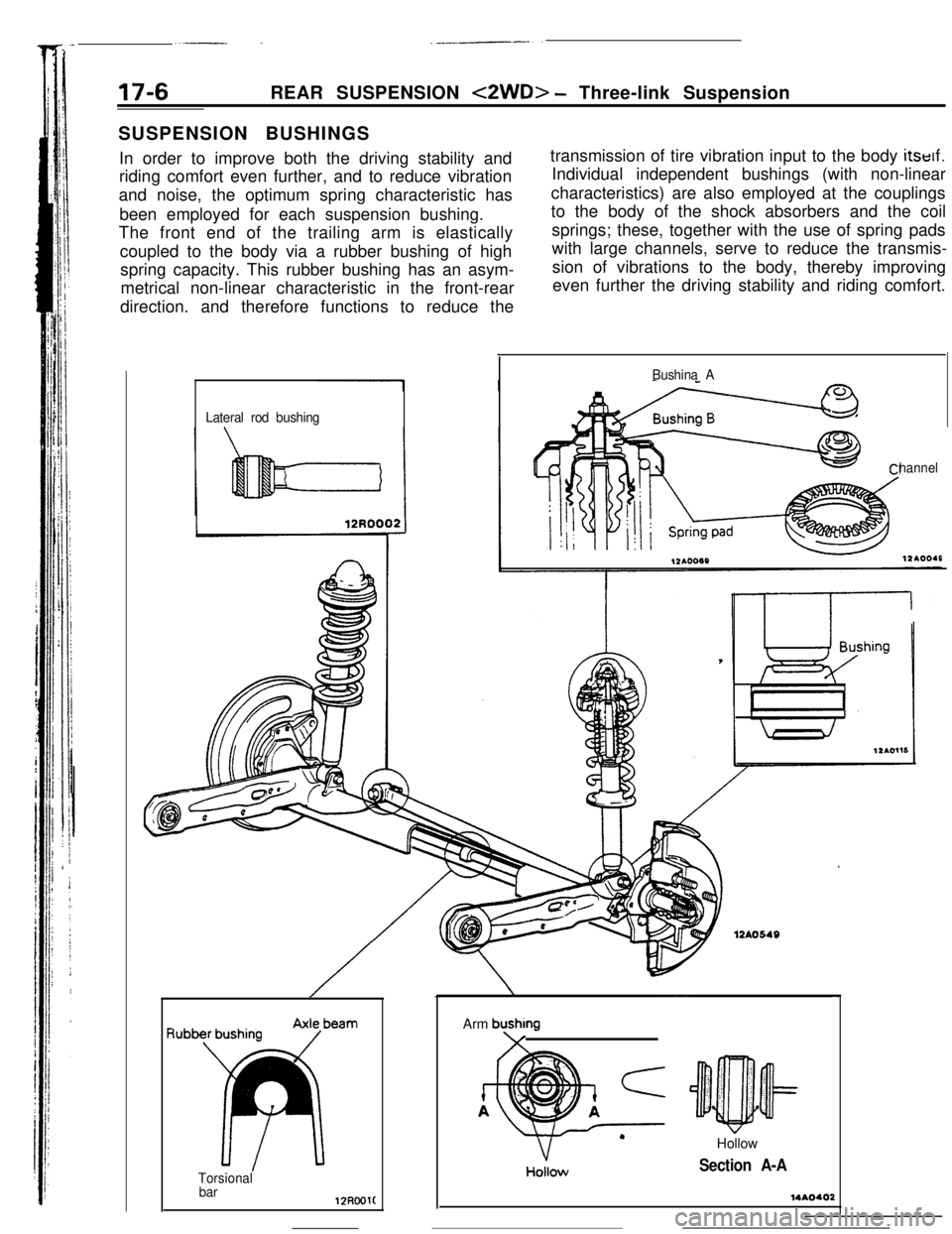
17-6REAR SUSPENSION <2WD> - Three-link Suspension
SUSPENSION BUSHINGS
In order to improve both the driving stability and
riding comfort even further, and to reduce vibration
and noise, the optimum spring characteristic has
been employed for each suspension bushing.
The front end of the trailing arm is elastically
coupled to the body via a rubber bushing of high
spring capacity. This rubber bushing has an asym-
metrical non-linear characteristic in the front-rear
direction. and therefore functions to reduce thetransmission of tire vibration input to the body itself.
Individual independent bushings (with non-linear
characteristics) are also employed at the couplings
to the body of the shock absorbers and the coil
springs; these, together with the use of spring pads
with large channels, serve to reduce the transmis-
sion of vibrations to the body, thereby improving
even further the driving stability and riding comfort.
Lateral rod bushingBushina A
hannel
f3ub
Torsional
barArm
bushmg\/HollowHoilow
Section A-A
Page 200 of 391
/cY
REAR HUBREAR SUSPENSION
<2WD> - Rear Hub
Rl7FMA
17-7The rear hub has built-in unit ball bearing to secure
high bearing and hub accuracy. By simply tightening
the nut to specified torque, optimum preloading is
achieved for easier servicing.
Unit ball
a -\ Rear hub
/‘YLLY -Nut
12A0550
Trending: ECU, fuel reserve, engine, seats, fuse, ABS, child restraint
